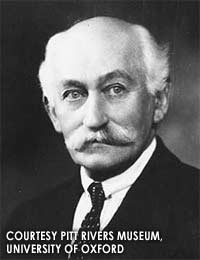
Balfour was President of the Museums Association, the Royal Anthropological Institute, and the Royal Geographical Society. He was also appointed a fellowship of the Royal Society and later the Oxford University gave him the personal title of Professor of Ethnology.
Henry Balfour is not known as a famous field archaeologist, or a celebrated treasure hunter, nor was he infamous for hoaxes or fakes. He is one of archaeology’s quiet background individuals who tirelessly championed the work of others with little public recognition for himself.
The Pitt-Rivers Collection
He was born in 1863, at Croydon, England. He was the founding curator of the Pitt Rivers Museum. He began work at the museum when he was only 22 years old after entering undergraduate studies in Natural Science at Oxford University. Lt-Gen Augustus Pitt-Rivers had amassed an enormous collection of archaeological treasures and wished for them to be on permanent display. The Pitt-Rivers collection was moved to a newly constructed ‘home’ at Oxford University and Balfour accepted the laborious challenge of cataloguing, making drawings, writing labels, cleaning and repairing artefacts, assisting in building display cases, and then arranging the exhibition of the entire collection for public viewing.
Although his initial appointment was for only 12 months he soon negotiated a permanent contract and his efforts were rewarded with promotion to Sub-Curator of the new museum. Before the turn of the century he would be appointed and known as ‘Curator of the Pitt Rivers Museum of Oxford University’. This elevated position gave him the same rank and status as the professors who worked in the main University Museum. He held this position for over 40 years.
Artefacts From Around the World
As new acquisitions arrived from around the globe, the young Henry worked hard to set up meaningful and interesting displays, adding to and rearranging his exhibits frequently. Over the years he established many professional relationships and through these friends and colleagues he was able to extend and develop the Museum’s substantial collections.
By the early 1890’s Balfour was delivering formal lectures to students of the University. One of his anthropology students recalls,
“Our work with Mr Balfour was done entirely in the Pitt-Rivers Museum, of which he was Curator, before exhibition cases which frequently were supplemented with trays or handfuls of additional specimens…”
Balfour’s hands-on approach to lecturing was deeply appreciated by the students and many graduates went on to work overseas as ethnologists or colonial administrators. So highly was he thought of at the Museum that those who took up colonial appointments abroad often sent back to Balfour archaeological objects that they had ‘acquired’ for his inclusion in the Pitt-Rivers Museum collections.
Henry Balfour the Writer
Although the Museum consumed much of his energies he was sufficiently diverse to publish a number of scholarly articles on rather unusual topics such as fishing using kites, musical bows, and even one titled “The Fire Piston” for the Annual Smithsonian Report of 1907. He demonstrated his professional academic inclination to higher research by inviting his readership to submit additional information from those with similar experiences.
Balfour was a great traveller. And as such acquired a great number of interesting artefacts worthy of museum display. In fact, other than Pitt-Rivers himself, Balfour gave the highest number of objects to the Museum. The records show that he sourced in excess of 15,000 objects including lithic tools, objects used in fire production, and many weapons.
Henry Balfour was never engaged in any on site excavations nor did he personally discover even one significant artefact. However, his presidency over the Pitt-Rivers Museum for its first fifty years meant that the real impact of his work was in raising archaeology before the public and confirming it as a professionally accepted science.